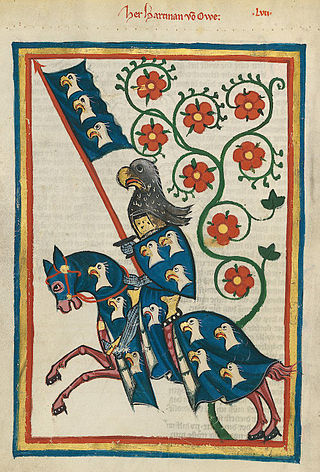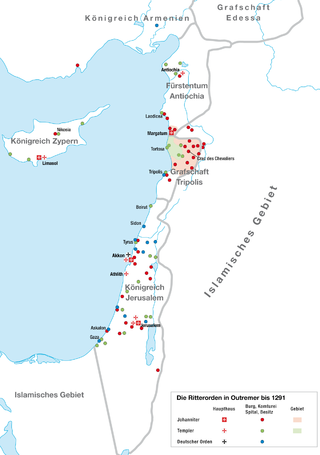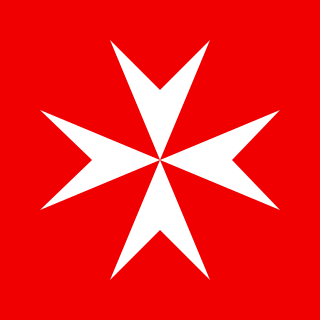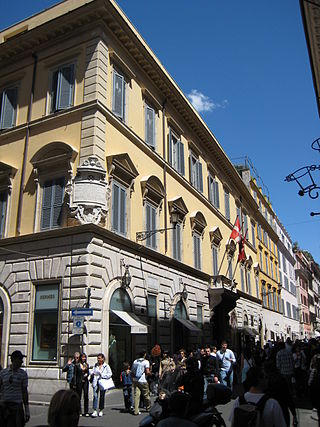
A knight is a person granted an honorary title of knighthood by a head of state or representative for service to the monarch, the church or the country, especially in a military capacity. Knighthood finds origins in the ancient Greek hippeis (ἱππεῖς) and Roman equites.

The Sovereign Military Order of Malta (SMOM), officially the Sovereign Military Hospitaller Order of Saint John of Jerusalem, of Rhodes and of Malta, commonly known as the Order of Malta or Knights of Malta, is a Catholic lay religious order, traditionally of a military, chivalric, and noble nature. Though it possesses no territory, the order is often considered a sovereign entity under international law.

A military order is a Christian religious society of knights. The original military orders were the Knights Templar, the Knights Hospitaller, the Order of Saint James, the Order of Calatrava, and the Teutonic Knights. They arose in the Middle Ages in association with the Crusades, both in the Holy Land, the Baltics, and the Iberian peninsula; their members being dedicated to the protection of pilgrims and Christians, as well as the defence of the Crusader states. They are the predecessors of chivalric orders.

The Equestrian Order of the Holy Sepulchre of Jerusalem, also called Order of the Holy Sepulchre or Knights of the Holy Sepulchre, is a Catholic order of knighthood under the protection of the Holy See. The pope is the sovereign of the order. The order creates canons as well as knights, with the primary mission to "support the Christian presence in the Holy Land". It is an internationally recognized order of chivalry.
The fount of honour is a person, who, by virtue of his or her official position, has the exclusive right of conferring legitimate titles of nobility and orders of chivalry on other persons.

The Bailiwick of Brandenburg of the Chivalric Order of Saint John of the Hospital at Jerusalem, commonly known as the Order of Saint John or the Johanniter Order, is the German Protestant branch of the Knights Hospitaller, the oldest surviving chivalric order, which generally is considered to have been founded at Jerusalem in 1099.

The Royal Order of the Seraphim is a Swedish order of chivalry created by King Frederick I on 23 February 1748, together with the Order of the Sword and the Order of the Polar Star. The order has only one class with the dignity of Knight, and is the foremost order of Sweden.

An order of chivalry, order of knighthood, chivalric order, or equestrian order is an order of knights, typically founded during or inspired by the original Catholic military orders of the Crusades and paired with medieval concepts of ideals of chivalry.

Grand Master is a title of the supreme head of various orders, including chivalric orders such as military orders and dynastic orders of knighthood.
Commander, or Knight Commander, is a title of honor prevalent in chivalric orders and fraternal orders.
Order of Saint John or Knights Hospitaller is a chivalric order of the Crusades and early modern period, after 1530 also known as "Knights of Malta"

The Order of Knights of the Hospital of Saint John of Jerusalem, commonly known as the Knights Hospitaller, was a medieval and early modern Catholic military order. It was founded in the Kingdom of Jerusalem in the 12th century and had headquarters there until 1291, thereafter being based in Kolossi Castle in Cyprus (1302–1310), the island of Rhodes (1310–1522), Malta (1530–1798), and Saint Petersburg (1799–1801).

Palazzo Malta, officially named as the Magistral Palace, and also known as Palazzo di Malta or Palazzo dell'Ordine di Malta, is the more important of the two headquarters of the Sovereign Military Order of Malta, a Roman Catholic lay religious order and a sovereign subject of international law. It is located in Via dei Condotti, 68 in Rome, Italy, a few minutes' walk from the Spanish Steps, and has been granted extraterritoriality by the Italian Government. The Palace has been a property of the Order of Malta since 1630.
A self-styled order or pseudo-chivalric order is an organisation which claims to be a chivalric order, but is not recognised as legitimate by countries or international bodies. Most self-styled orders arose in or after the mid-18th century, and many have been created recently. Most are short-lived and endure no more than a few decades.
The orders, decorations, and medals of the Holy See include titles, chivalric orders, distinctions and medals honoured by the Holy See, with the Pope as the fount of honour, for deeds and merits of their recipients to the benefit of the Holy See, the Catholic Church, or their respective communities, societies, nations and the world at large.

The International Commission for Orders of Chivalry is a privately run, privately funded organisation composed of scholars on chivalric matters and systems of awards. Founded in 1960, its stated purpose is to examine orders of chivalry to determine their legitimacy. Its president since 1999 is Pier Felice degli Uberti, and its seat is situated in Milan, Italy.

The Military and Hospitaller Order of Saint Lazarus of Jerusalem is a Christian self-styled order that was statuted in 1910 by a council of Catholics in Paris, France, initially under the protection of Patriarch Cyril VIII Geha of the Melkite Greek Catholic Church. During the 1920s, it expanded its jurisdiction and enrolled members from other countries in Europe and in the Americas. It re-established the office of grand master in 1935, linking the office to members of the Spanish branch of the House of Bourbon. It assumed an ecumenical dimension during the 1950s to expand its membership to individuals of other Trinitarian Christian denominations in British Commonwealth countries.
The Grand Master of the Order of Saint Lazarus was the leader of an order of chivalry that was established by the Holy See in the 12th century. A number of Masters of the order, eventually termed Grand Masters, have been listed by previous historians of the order.

The navy of the Order of Saint John, also known as the Maltese Navy after 1530, was the first navy of a chivalric order. It was established in the Middle Ages, around the late 12th century. The navy reached its peak in the 1680s, during the reign of Grand Master Gregorio Carafa. It was disbanded following the French invasion of Malta in 1798, and its ships were taken over by the French Navy.















